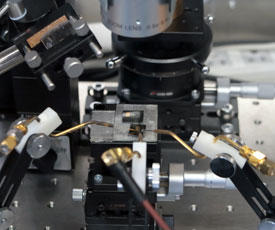

11/27/2017

© 2017 Thangavel Kanagasekaran
Electrodes capable of injecting both electrons and their positively charged counterparts — holes — into flexible semiconductors made from organic materials have been devised by a team of researchers at the AIMR and Tohoku University1. These electrodes are promising for realizing high-performance organic-based optoelectronic devices, as well as organic logic circuits and lasers.
Organic semiconductors offer many advantages over conventional silicon-based ones. For a start, they are flexible, which means they can be used in wearable electronic devices and smart clothing. They are also printable and lightweight, can be made at low temperatures, and can generate light at high efficiencies. But unlike their inorganic counterparts, it is hard to inject electrons into organic semiconductors because metals suitable for electron-injection electrodes, such as calcium, are unstable in air.
Now, Thangavel Kanagasekaran of the AIMR at Tohoku University and his colleagues have overcome this problem by coming up with an electrode that has a unique structure: a disordered organic semiconductor layer sandwiched between a metal thin film and a single-crystal organic semiconductor layer.
The structure has a novel carrier injection mechanism that results in a very low carrier injection barrier, so that there is very little resistance between the electrode and the organic semiconductor, regardless of the material that the electrode is made from. The electrode is also effective for efficiently injecting both electrons and holes — previously, electrodes made from different materials had to be used to inject holes and electrons into organic semiconductors.
The team demonstrated the possibilities of their electrodes by using them in field-effect transistors based on a single-crystal organic semiconductor. Using this setup, they achieved the highest electron and hole mobilities for two terminals so far. The electrodes also enabled bright light emission from the organic semiconductor with a very high current density.
“With this structure, the effective barrier height for carrier injection is almost independent of the metal, allowing us to use any metal that is stable in air for electron injection,” explains Kanagasekaran. “The great thing about this method is its versatility: it can be applied to any metal or organic semiconductor and can be used to inject both electrons and holes,” he adds.
Kanagasekaran notes that while the single-crystal organic semiconductor the team used is stable in air, it cannot conduct electrons in air. He and the team are now working on extending the technology by developing devices that are able to be operated in air.
This research highlight has been approved by the authors of the original article and all information and data contained within has been provided by said authors.